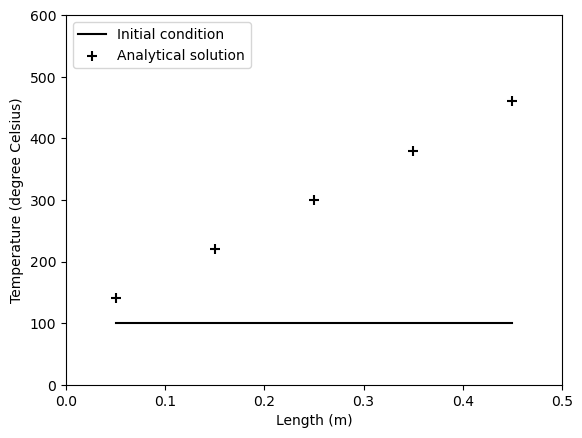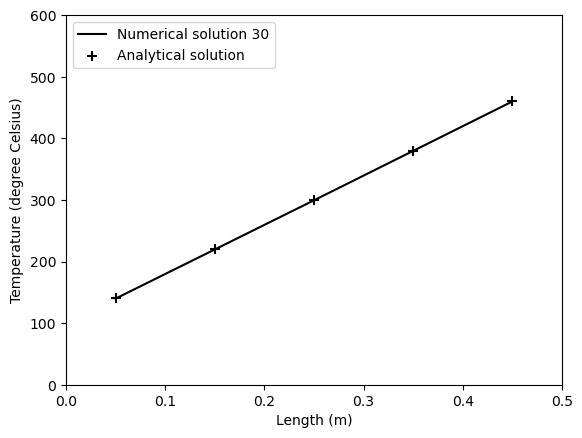1D steady-state diffusion#
Diffusion problems study the spreading of substances (e.g., heat, particles, or pollutants) over time due to random motion, governed mathematically by the diffusion equation. At steady state, the solution depends on boundary conditions (e.g., fixed values or fluxes at edges), with applications spanning heat transfer, environmental pollutant dispersion, biological transport, and material science. The problems are analytically solvable in simple geometries but often require numerical methods for complex scenarios.
Problem setup#
The adiabatic rod has a length \(L=0.5\) m, corss-sectional area \(A=10\times10^{-3}\) m\(^2\), left-end temperature \(T_A=100\) °C, right-end temperature \(T_B=500\) °C, and thermal conductivity \(k=1000\) W/(m\(\cdot\)K). Determine the steady-state temperature distribution.

The mathematical model for one-dimensional steady-state diffusion problem is
The boundary conditions are
The analytical solution for the temperature distribution at steady state is
Solve problem#
Define 1D grid#
Divide the rod evenly into 5 control volumes, as a result, \(\delta x=0.1\) m.

Discretize 1D diffusion equation#
Make \(k = k_w\) and \(A = A_w = A_e\), derive the discrete equations for the internal and boundary nodes as following.
Internal Nodes 2, 3 and 4
The discrete equation satisfied by the internal nodes in the rod is
where
Boundary Node 1
The discrete equation for the boundary node 1 is
where
Boundary Node 5
The discrete equation for the boundary node 5 is
where
Solve algebraic equations#
# Step 0: import required libraries
import numpy as np # for array operation
from matplotlib import pyplot as plt # for plotting figures
# Step 1: parameter declarations
nx = 5 # number of spatial grid points
k = 1000 # thermal conductivity
L = 0.5 # length of the rod
A = 0.01 # cross-sectional area of the rod
TA = 100 # temperature at x = 0
TB = 500 # temperature at x = L
nt = 30 # number of iterations
dx = L / nx # spatial grid size
coeff = k*A/dx # coefficient for west terms
x = np.linspace(0.5*dx, L-0.5*dx, nx) # spatial grid points
# Step 2.1: set initial condition
T = np.ones(nx) * TA # a numpy array with nx elements all equal to TA
# Step 2.2: visualize initial condition and analytical solution
plt.figure() # create a new figure
plt.plot(x, T, '-k', label='Initial condition')
plt.scatter(x, TA-(TA-TB)/L*x, s=50, c='k', marker='+', label='Analytical solution')
plt.xlabel('Length (m)')
plt.ylabel('Temperature (degree Celsius)')
ax = plt.gca()
ax.set_xlim(0, 0.5)
ax.set_ylim(0, 600)
plt.legend(loc='upper left')
plt.show() # show the figure

# Step 3: finite volume calculations
Tn = np.ones(nx) # placeholder array to advance the solution
for n in range(nt):
Tn = T.copy() # copy the existing (old) values of T into Tn
# left boundary
T[0] = (coeff*Tn[1] + 2 * coeff*TA) / (coeff + 2*coeff)
# internal nodes
for i in range(1, nx-1): # skip the first and the last elements
T[i] = (coeff*Tn[i-1] + coeff*Tn[i+1]) / (2*coeff)
# right boundary
T[-1] = (coeff*Tn[-2] + 2*coeff*TB) / (coeff + 2*coeff)
# calculate the temperature difference for convergence
Tdiff = np.sum(np.abs(T - Tn)) # total temperature difference
if (n+1) % 10 == 0: # print every 100 iterations
print('Iteration {}: Tdiff = {:.3f}'.format(n+1, Tdiff))
Iteration 10: Tdiff = 26.337
Iteration 20: Tdiff = 3.468
Iteration 30: Tdiff = 0.457
# Step 4: visualize results after advancing in time
fig = plt.figure()
plt.plot(x, T, '-k', label='Numerical solution {}'.format(n+1))
plt.scatter(x, TA-(TA-TB)/L*x, s=50, c='k', marker='+', label='Analytical solution')
plt.xlabel('Length (m)')
plt.ylabel('Temperature (degree Celsius)')
ax = plt.gca()
ax.set_xlim(0, 0.5)
ax.set_ylim(0, 600)
plt.legend(loc='upper left')
plt.show()

Note
The variable \(n\) here represents a pseudo-time that advances the simulation to converge towards the analytical solution.
Exercise#
Try to do more iterations and observe the final temperature difference.
Modify the code so that a small tolerance for the error (e.g., 10\(^{-5}\)) can be specified to obtain a convergent result.